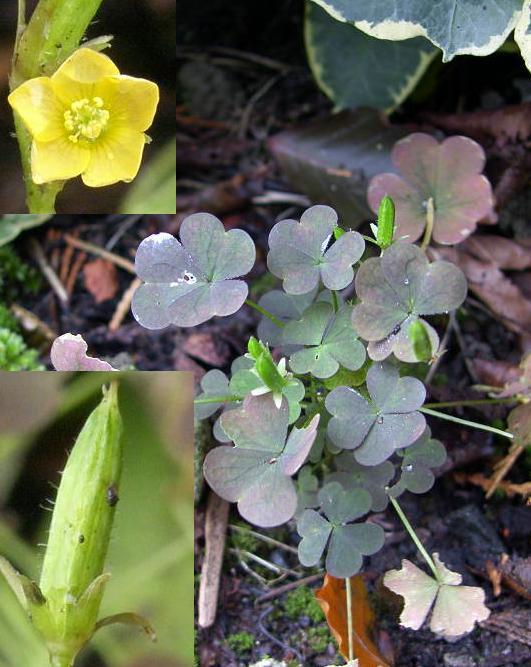Creeping Wood SorrelScientific Names: Oxalis corniculata var. atropurpurea syn. O. repens |
This is a perennial can be very invasive, quickly covering the surface as the creeping stems take root at nodes. It produces many seed which are dispersed by explosive pods and they re-infest the area after attempts at removal. It was probably introduced as an ornamental plant. The origin is not known, but it is related to Least Yellow Sorrel which comes from Tasmania and New Zealand
The leaves are divided into three rounded leaflets which have short petioles. The picture is of the purple variety which is the most common plant found in the garden where it can be a persistent pest, but there are green forms as well. In shaded positions there can be a greenish tinge to the purple form, as seen here
The leaves contain vitamin C and oxalic acid which gives them the tangy taste of other members of the Genera, but must not be consumed in large quantities due to the binding of Calcium making it unavailable, leading to deficiency. A refreshing drink can be prepared by infusing the leaves in hot water for 10 minutes. The raw leaves or flowers can be used in salads or cooked with other leaves - cooking reduces the toxic effects. It can exacerbate conditions such as arthritis, rheumatism, gout and kidney stones so sufferers should avoid.
As a medicinal herb it has anthelmintic (kills intestinal worms), astringent and styptic (stems bleeding) properties. The leaf juice eases wasp and other alkaline stings, and has an antibacterial action.
It is difficult to remove by cultivation as any remaining rooted stems will regrow. The reservoir of seed will continue to germinate for many years, so even after all of the plants are eradicated, new ones can germinate if the soil is disturbed, even years later. A mulch should prevent germination on cleared soil. It is also easily imported in soil with transplants.
Glyphosate should work eventually, but the seed will continue to germinate. A residual agent should prevent germination for a while. In the lawn it avoids the sweep of mower blades; it can be treated with a selective weedkiller with some fertilizer to thicken the sward and reduce the germination of seed.
See also Clover, Least Yellow Sorrel and Wood Sorrel.
